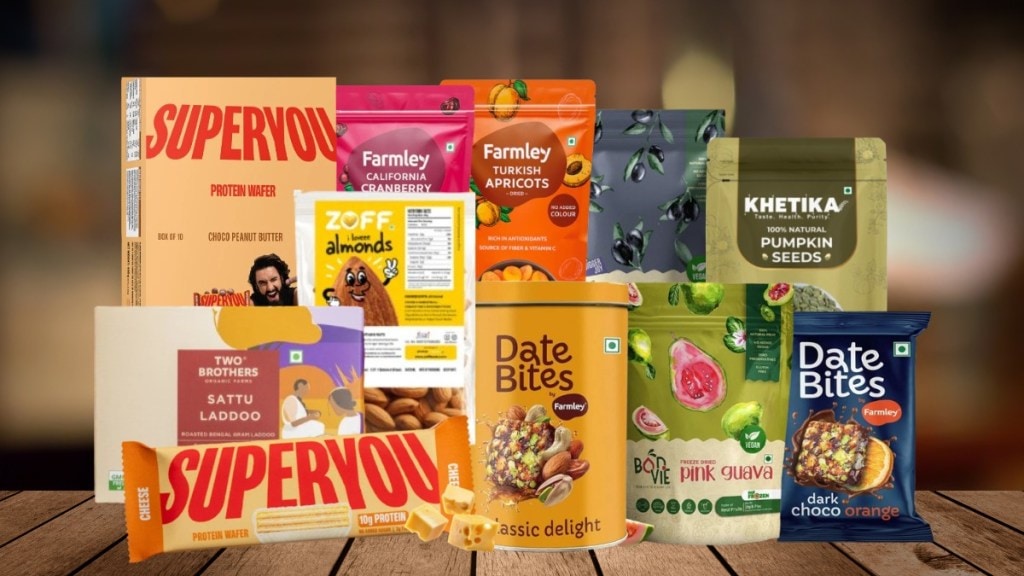On a Tuesday afternoon in Bengaluru’s Indiranagar, a young professional steps out of a co-working space, not for chai and pakoras, but for a pouch of peri-peri makhana and a protein wafer. In her hand, the glossy packaging is as much a statement as the contents inside; this is snacking for a generation that wants indulgence without guilt.
India’s snack shelves have long been dominated by the fried, the spicy, and the familiar. Namkeens, bhujia, banana chips, and masala wafers have fueled tea breaks, train journeys, and late-night hostel conversations for decades. But in the last five years, a wave of startups has been quietly rewriting the script, tapping into a market that, by 2033, is expected to touch Rs 1,01,811 crore as per IMARC data. Healthy snacking, once an oxymoron in the Indian context, has become a lucrative, fast-growing segment, projected to touch $4.6 billion by the same year.
Breaking the ‘healthy = boring’ myth
The change is visible not just in metros but in smaller towns, where label-reading and portion-control are creeping into everyday choices. “Healthy equals boring — that was the myth we had to break,” Atul Gupta, founder of Bonvie Snacks, which introduced freeze-dried fruits and air-fried vegetable chips to a sceptical audience, told financialexpress.com. “In India, snacks usually mean something fried, spicy, and loaded with flavour. We had to prove healthy could be exciting too.” Bonvie’s pitch marries nostalgia and nutrition: makhana, ragi, jamun and mango reimagined in crunchy, travel-friendly forms.
Trust as the new ingredient
For Dr. Prithwi Singh, co-founder of Khetika, the challenge was deeper — “rebuilding trust in everyday food” in a market flooded with labels claiming ‘organic’ or ‘low-fat’. His answer lay in traditional wisdom backed by modern convenience: flax, sunflower seeds, millets, and dry fruits sourced directly from 14 states, slow-roasted and stone-ground to preserve nutrition. “Consumers aren’t looking for compromises,” he said. “They want both taste and transparency.”
The emphasis on trust runs through this new snacking wave. Akash Sharma, co-founder of Farmley, recalls the early disbelief when he suggested roasted makhana could replace bhujia. “It wasn’t enough to say ‘this is healthy’. We had to prove it could also feel indulgent,” he noted. Farmley’s solution was flavour-first innovation, peri-peri and minty pudina makhana, five-in-one seed mixes, all in clean, modern packaging. Their Healthy Snacking Report 2025 found that 65% of consumers now prefer makhana in their daily snacking habits.
“We wanted to marry traditional grains like millets and legumes with flavours and formats Indians already love,” Nikunj Biyani, founder, SuperYou, added. His protein-infused wafers and multigrain chips are aimed squarely at Gen Z and first-jobbers who, he noted, “are looking to snack, but better — not compromise on taste or convenience.”
Heritage, reframed
Others have taken a more heritage-driven approach. At Two Brothers Organic Farms in Maharashtra, co-founder Satyajit Hange insists the future of snacking lies in the past. “Your grandmother’s kitchen is the next big trend,” he commented. Their panjiri, jaggery laddoos, and amla-based formulations stick to traditional recipes but arrive in modern, aesthetically pleasing formats. “People have moved from ‘low-fat’ buzzwords to asking about good fats and functional benefits. That’s when traditional foods, reframed, start to shine.”
If taste and trust are the bedrock, design is the billboard. “In an Instagram-first world, how your product looks is almost as important as how it tastes,” says Bonvie’s Gupta. From Farmley’s clutter-free packs to ZOFF Foods’ resealable dry fruit pouches, visual branding is a competitive arena. “Consumers often discover us online first,” noted Akash Agrawalla of ZOFF, whose peri-peri almonds and saffron-kesar raisins balance Indian sourcing with global flavour profiles. “Packaging is our first conversation with them.”
The hard economics of healthy
But getting that conversation started isn’t always easy. Ajay Kangralkar of SkyRoots Ventures, which makes baked millet-based snacks, points to the hard economics: “We’re dealing with a price-constrained market. Shelf space is expensive, and big brands dominate. More than 80% of products are fried; we proudly say ours are baked, but pricing it right for the masses is a constant challenge.” His answer has been institutional channels, from corporate canteens to vending machines.
The numbers suggest the shift to mindful snacking is not a passing fad. Healthy snacks are growing 1.2 times faster than traditional ones; single-serve packs are expanding 60% faster than regular small packs. Nearly 73% of urban consumers are willing to pay more for food that supports health and well-being. And while metros lead adoption, tier-2 and tier-3 cities are catching up quickly, aided by quick commerce platforms like Blinkit and Swiggy Instamart.
Hange sees a deeper behavioural change: “People aren’t just buying out of curiosity anymore, they are subscribing to this category. That shift from trial to loyalty is very telling.” His laddoos and millet snacks have become repeat purchases, with over a third of buyers returning within a year.
It’s a shift the big players are watching closely. With brands like Marico acquiring healthy snack labels and IPOs like Gopal Snacks raising funds for expansion, consolidation seems inevitable. For now, the startup wave is thriving on agility, storytelling, and cultural resonance. Back in Indiranagar, the young professional opens her packet of makhana, snaps a picture for Instagram, and takes a bite. In that crunch is a story of farmers in Bihar, food scientists in Pune, designers in Delhi, and a consumer who wants both taste and health. The shelves may still be lined with namkeen, but the snack aisle’s future is looking lighter, cleaner, and a whole lot crunchier.

